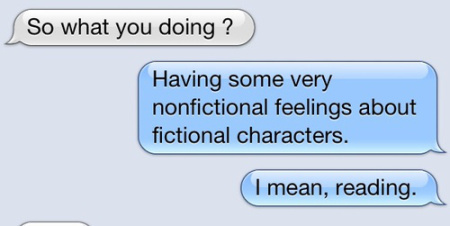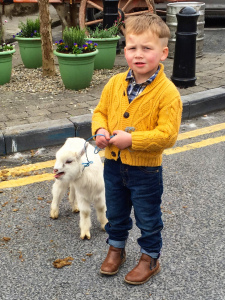Eric Witchey's Blog: Shared ShadowSpinners Blog , page 22
June 8, 2016
What I learned about fictional characters by watching Downton Abbey
Spoiler alert: If you have not watched this series and intend to, do not read this.
I binge-watched Downton Abbey. Six seasons in two weeks, give or take, while my husband was fishing. As most of you know, this is a completely different experience from watching one hour a week for six years. I was immersed, and could therefore follow storylines very closely. Perhaps too closely.
These are some of the things I learned about a television series that captured the imaginations of pretty much everybody who watched it. We want to learn from the winners.
The Upstairs people had ridiculous problems, and many of the characters were annoying in their lack of self-awareness. When Mary was on the screen, I went to the kitchen for another cup of coffee, or leafed through a magazine. She grated on me.
The opposite of Mary was the Dowager Countess. Loved her. Love Maggie Smith in anything, but in this series, she had the best lines and the best facial expressions.
The Upstairs men were all stupid, and the women surreptitiously controlled everything. I kind of enjoyed this subplot, as His Lordship Earl of Grantham was the big cheese, but never did anything productive in his life except lose his wife’s fortune and love his dog. Her Ladyship the Countess of Grantham knew what was what and took care of business, at least as much as her headstrong daughters would allow.
The Downstairs people were fascinating. I loved every one of them, even the sinister Thomas Barrow, who became not only sympathetic, but eventually redeemed himself. This was a plot line that worked very well for me through the entire series.
The relationship between the Housekeeper, Mrs. Hughes and the Butler, Mr. Carson (he was fantastic!) charmed me. Ditto the relationship between the Cook, Mrs. Patmore, and her assistant Daisy.
My heart was really with the poor Mr. Bates and his darling wife. They were adorable individually and together, and the genius of the show (their storyline was really what kept me interested) is that they were the absolute picture of truth, goodness, and beauty, and injustice kept falling on their heads. First, he’s in prison, then she’s in prison, for offenses they didn’t commit. Then they couldn’t marry. Then they could marry but couldn’t inherit his dead wife’s ill-gotten estate. Then they couldn’t have a baby, the only thing they really wanted. For some reason, the fact that the Upstairs people were fertile and ashamed of it while these sweet people kept miscarrying invoked an interesting series of emotions.
The series lasted one year too long. The writers were reaching for storylines by the end.
So, what did I learn about fiction from this marathon binge?
Visit continual and horrific injustices on the nicest people.
Let evil people run their evil almost to the breaking point, and then make them pay with whatever is dearest to them.
Reward good people for their good works, but do it with a light touch. Let the reader/viewer fill in the happy ending details. Remember, fiction is about conflict.
Let those who are their own worst enemy reap the rewards of their own making.
Let the wily old ladies steal the scene. And
Don’t keep writing just because you love the characters. Know when to quit, put in a period and write “The End.”
I know, these are not new insights, nor are they earth-shattering revelations. But it’s always good to pick apart something that works and see what makes it tick.
And now a question for you: What did you learn about fictional characters by watching the series finale of The Good Wife?
Tagged: Characters, creativity, Downton Abbey, fiction, The Good Wife, writing


June 2, 2016
My New Writing Mantra: Keep Buggering On
 By Lisa Alber
By Lisa Alber
A few weeks back I found myself driving and whimpering with anxiety. I’d been struggling with the ending of my current first draft. I knew the whodunnit and the whydunnit and the howdunnit, so … why wasn’t the ending falling into place?
I realized that instead of wasting my time trying to shoehorn an ending into what I had, I needed to rethink everything before it! Great, after all these months of writing, *now* I realized I might have huge plot issues?
I decided to start the revision process. So, here I am revising without having gotten to “the end.” It’s the writing equivalent of “keep buggering on,” as Winston Churchill now famously said. I’m cutting ten percent off the top, BAM, because I overwrite my first drafts. In the process, I’m honing in on character motivations and emotions, which can only help me when I face the “the end” once again.
In fact, yesterday I had a little blip of a thought, an idea for a scene near the end. The oh-yeah feeling hit me — excitement! — so I wrote down my idea, and now I’m looking forward to getting there.
I like looking forward to things, whether they be endings, parties, travel, or holing up with someone else’s novel. But ultimately, to get the work done, I need to return to the moment I’m in with this scene, right now.
And keep buggering on. Seems to me that this is what writing is really all about.
Tagged: first drafts, Keep buggering on, revision, Winston Churchill, writing


May 25, 2016
Your Money or Your Muse
by Christina Lay
Not long ago I read an informative post about marketing for self-publishing writers and – surprise surprise – it rubbed me the wrong way. Not because I didn’t believe the writer’s observations, but because I’d prefer it if they weren’t true.
Her advice was, in a nutshell, when deciding what to write, you should “follow the market”. Okay, sure. If you’re one goal as a writer is to make money, this makes perfect sense. But what about following your heart, your muse, the inner voice that tells you which stories move you and which stories are just “meh”? This can be inexplicable to non-writers who tend to ask “why don’t you write the next Harry Potter Twilight Fifty Shades of the Davinci Fill In the Blank?” The writer of the aforementioned article, who writes (wrote?) YA, says she’s giving up on YA because kids don’t have disposable income. Hmmm.

Naturally, if you’re every bit as fired up to write a steamy thriller as you are that novel length prose poem exploring the social aspects of embroidery in the 1700s, I’d fully support a decision to go with the thriller. But if you love writing YA, do you really need to abandon it because you haven’t hit the mark with readers yet?
She also says she’s giving up a series she loves because it’s not selling. Again ,this might be totally legitimate if you’ve got other projects singing their siren song in your ear, but I’d really question the impulse to give up all the blood, sweat and tears you’ve put into a series solely based on financial considerations. I happen to think this is how we get inundated with mediocre shlock. Writers giving up what they love for what they know they can “crank out” and what, according to the numbers, people want to read.
I actually had one acquaintance suggest that I write what people want to read. If you can tell me (and the rest of the publishing world) what the next Harry Potter Twilight Fifty Shades of Divinci will be, do tell. But the truth is, what’s hot right now might be dead in the water tomorrow. What’s languishing in the backwaters of Amazon’s sub sub categories might suddenly leap into the bestseller ranks. Do I really want to let algorithms and rankings choose which stories I write?
Not so much. I was recently invited to write a book in a shared-world series. The idea was interesting, so I came up with an off-the-cuff idea and accepted. I have to admit I was more interested in riding on the coat tails of the more established authors included in the project than I was in the story I’d come up with, but I was sure I could find “the juice” and make the premise work for me. That book was one of the least rewarding things I’ve written. Yes, it had its moments, enough to get me through, but as I sent off my submission I wasn’t congratulating myself on a job done, but thinking “well, no writing is wasted writing”. In other words, I learned how to tough it out through a financially motivated project, but it left me feeling drained and hollow rather than triumphant. And when you finish an entire freakin’ novel, you should feel triumphant, at least for a little while.
Now I admit I’m not the best person to take marketing advice from (a glance at my Amazon rankings will tell the sad tale) but one thing I can tell you without hesitation is that I love to write. I am that annoying person who eagerly shuffles to the desk every single day and writes. Somehow, despite being under-published and underpaid, I’ve carved out a writing life for myself, and I have not done it by letting the market make my writing choices for me. So I guess my counter advice to “follow the market” is to ask yourself why you’re writing. Ask yourself what you want to write, which is often what you want to read. Ask yourself how you’re going to assign value to your work. Is it how much money you make, or how much joy it gives you? Then, make your choice. And with any luck, what you really want to write will become what people really want to read.

Tagged: author, creative process, Marketing, Muse, Short Story Writing, writing


May 18, 2016
When you’ve got nothing …
Nothing is a blank page, an empty mind, too little sleep, and a present deadline. But the value of nothing is generally underrated. What use is a bowl without the emptiness inside? What use is a door without a hole to walk through? So here I go, wandering here and there among the words, like a hermit wanders among the woods, noticing this and that, aimless and happy.
As writers, we tend to think writing is a big deal. The more serious we are about it, the bigger a deal it must be. How else will we lend weight to our words? Even, how else will we give purpose to our lives? But all our thoughts are only thoughts. All our words are only words. In the very next moment or in ten billion years they will all amount to nothing. And life is beautiful without any purpose whatsoever.
So if you’re facing a blank page and you’ve got nothing. Don’t despair. In fact, empty yourself even more! Forget the writer you imagine yourself to be or not be. Wipe away all the memories of an ancient past. Discard all predictions of an uncertain future. Beneath your left heel stomp out fear, and beneath your right heel crush all hope. Empty yourself completely. Become nothing … a blank page. And you will see: it is from this nothing, and nothing else, that all things have their origin.
Look around.
The world itself is made of poetry.
Just notice, and transcribe.
Tagged: creative process, creativity, Matthew Lowes, writers, writing, writing habits


May 11, 2016
Story Shaman’s Gift, by Eric Witchey

Source: iStockPhoto, imgorthand.
The Story Shaman’s Gift, by Eric Witchey
Today, I received a letter from a friend, occasional student, and author. She knows who she is, and I thank her for reminding me of something very important. Our work as writers—our learning, stories, and teaching —are gifts to our readers, to our culture, and to other writers.
Once upon a time, I felt the need to thank one of my author heroes. In my formative years, and later as an adult learning to write, I lived in his stories for many hundreds of hours. Realizing that he was aging and had been very important to my growth as a human being and writer, I decided to send him a thank you note in which I described how I used to hide beneath the blankets of my bed on thunder-rattled nights in Northern Ohio. My military flashlight had a red filter to keep the enemy from seeing me while I read books in the dark. The enemy was my father, who would surely make me go to sleep rather than let me stay up reading until the wee hours. Thunder rattled the windows. Lightning turned my blankets into radiation shielding flashing with the glow of solar storms trying to penetrate my protections. For hours and hours at a time, I lived in the futures of my hero.
Later in life, I studied what he did and how he did it in hopes that one or more of my stories would transport a reader into new worlds in the same way. Later still, when my personal obsession with how stories work in the mind of the reader had fully matured into a need to teach useful craft skills, I returned to his work as an analyst.
When I wrote the letter, I just wanted to express my gratitude. I did not expect him to write back.
Ray Bradbury did write back, and he said two very important things to me. In his exact words, he said:
“When I was your age (mid-40s then), I had yet to write a decent poem or an essay I much cared for. Also I’d never written a play that I enjoyed. But in the following years I finally began to write some poems I liked, some essays, and some plays that were finally produced. It’s a matter of time and love.”
In my mind and heart, I heard:
We learn the craft of telling the tale of our world and the people in it every day until we die, and we give from our hearts until they stop. That is the path of the story shaman.
But, I forget.
Things eat at the soul: fifty rejections between sales, an agent who lied and killed deals, an ego-petty editor who went out of her way to tell me she tossed my requested manuscript in the garbage because she “couldn’t take all the manuscripts to her new office,” another story pirated, a family member dismissing writing as meaningless, another bill that means more time in corporate America, writing students who are proud of having never read a novel, petty writer pissing contests, and an endless march of swirling, chaotic, global self-destructive stupidity.
The little boy with the flashlight, Fahrenheit 451, The Illustrated Man, and The Martian Chronicles becomes more and more distant in heart and mind. The value of the life path of tales and teaching becomes hidden beneath ultimately meaningless, superficial modern tugs, tears, and turmoil.
Luckily, I framed that letter from Ray and put it on my office wall. Luckily, I had the father I had.
You see, many years after I hid under the covers reading with a flashlight, I came back home to Ohio and sat sipping scotch with my father. At the time, I didn’t know he would soon die. What I knew was that I loved him and we were having a moment. Thirty-something me confessed my nocturnal transgressions with Mr. Bradbury and others. Fifty-something him laughed and told me that he had known.
Who knew that a red-filtered flashlight made the covers glow from the inside?
He told me that as long as I was reading, he let me stay up as late as I wanted. If I was doing anything else, he made me go to sleep.
For a while, I sat quietly and considered this revelation. Finally, I asked him about school and how tired I must have been after reading all night.
He said, “Do you remember what you did during your days at school?”
“Not really,” I said. “I remember some stuff.”
“Do you remember the stories you read?”
“Every. Single. One.”
He nodded, smiled, and sipped his scotch.
Mind blown. Love. Gratitude. Tears.
This morning, facing this blog, in which I planned to write some intellectual drivel about figure ground recognition and its role in implication in description, I was feeling some resentment because it was interfering with my need to finish the final proofreading and revision of a long, long overdue novel, which I am pretty sure, in spite of kind assurances from my editor, is the worst story I have ever written and which I am terrified to let loose in the world. So, the child within was wrapped in a world-weary adult shell wrapped in depression wrapped in resentment covering fear. My steaming cup of coffee was the only bit of joy in my habitual, daily trudge up to my office.
Entering the office, I glanced at Ray’s letter on the wall. Still there. No change. Yeah. Whatever.
I read emails. Delete. Delete. Block. Block. Delete.
A note of gratitude for my work and help. Huh. Cool.
Okay, my morning suddenly contained two tiny bits of joy—cup of coffee and kind note from an author. I actually smiled. In fact, I got up and pulled down Ray’s letter for a read.
Ray was about love. He was about giving love through story to the world.
In the face of the crazy of the world, the crazy of damaged lives and twisted socialization, the crazy of our demons and destructive cultural constructs, writers tell stories. We write essays. We write poems. It’s about love. It’s about giving the gift of self and perspective to a father who knows the value of a novel, to a troubled child who lives in a wool radiation dome protected from a storm for one night, and to a world in desperate need of empathy and long-term perspective.
From the heart to the heart through words is the path of the story shaman.
Today, I am grateful for my life and all the people in it. Today, I will step through my darkness and arrange the little black squiggles on the white background in hopes that one person out there in our stormy night world has a red-filtered flashlight, a loving father, and an imagination that might help heal the world.
-End-


May 4, 2016
An Exhibit for Writing by Cheryl Owen-Wilson
I enjoy visual art in every form. It feeds an energy within me like food fuels the body. So when I’m visiting a new town the first thing I search out are the art venues. I recently visited Austin, Texas and toured The Blanton Museum of Art. I had two glorious hours to roam before being confined in a hotel conference room for the remainder of my stay. I play a game with myself when viewing art installations. First I visualize what the piece is saying to me. Only after I hear it speak do I read the artists statement to see what the artist wished to convey. Two of the installations spoke loudly, causing me to pause and view my chosen forms of creative expression in a new light. Each form of expression I use is tangible; however, until I was exposed to these particular art pieces I had not realized how much one (painting) was more so than the other (writing).
In my home, in the time it takes me to walk from the entryway and turn right into the living room I can view the progress I’ve made as an artist. Paintings from my early endeavors, to current day, hang side by side. If you were to enter my home and turn left from the entryway and walk down the hallway, you’d be in my studio where it’s quite apparent an artist is in residence. In the studio other than the usual paint spattered easel, paint tubes and paint brushes, you’ll find vertical stacks of framed, not framed, wrapped and not wrapped canvases. Some are complete, some are in progress, some are stark white just waiting for a vision to be created; and finally some would better serve the world if they became kindling for a nice campfire. Yes, from the visuals to the smell of oil paint and turpentine you and I would both know I’ve spent many, many hours painting. And if I so chose, I could display my art in an exhibit to a much broader audience. Thus my painting is a very tangible part of my home.
On the flip side, my other creative outlet of writing is not evident when entering my home or as I walk around searching for a muse to suit my current story. The only tangible evidence would be if you or I spent hours sorting through the many books on my bookshelves. There we would find Shadowspinners, A Collection of Dark Tales. Within its covers is a short story with my name as author. I do have many notebooks hidden in drawers, stories packed in plastic bins and of course my computer holds file upon file of the imaginary lives I’ve woven into short-stores, poems and even a half-finished novel or two. Don’t you as well? But as I said they are not evident, not hanging from walls. Even in the homes of my prolific, and well-published writer friends, while they have their books scattered amongst others on shelves, there is little evidence of the months and years they’ve spent stringing word after word together to create story. And now in this era of e-books and e-zines, holding your printed story as it sits between two covers is even less likely to occur. So instead of a pile of published books you have an inventory of e-books on sites such as Amazon. I’ve spent just as many hours placing black words on white paper as I’ve spent brushing paint on a white canvas. I realize writers can have an exhibit of sorts , when they publish a new book and they have a book signing. If you are lucky enough to have printed copies what a wonderful feeling of accomplishment it must be to sit at a table surrounded by your creations. But the realization that writing is not a tangible presence I can view as I walk through my home struck me as quite unfair.
The art exhibits I alluded to at the beginning of this blog led me to ponder how to exhibit, in my home, the many hours I spend writing. As I mentioned, the thing I most love about art is how each of our interpretations is filtered through our own view and lives. I’ve listed the artists name and gallery below each photo as I’m only giving you my interpretation of the piece. Each of these artists have a much more profound statement they wish you to understand when viewing their art. The deeper meanings revolve around their own unique time, political atmosphere and country in which they originated. I encourage you to view the artist’s statement of each piece.
In the first exhibit the artist marks the passage of time by creating one-inch thick plaster tablets each day. The number of tablets created each day varied depending on how much time the artist had available to create them. Each tablet is stamped with the date it was produced and organized into stacks recording each day’s labor.

“2244 Modules” Isabel Del Rio The Blanton Museum of Art
While viewing this piece I was a voyeur into writers workspaces prior to the computer age. It reminded me of the photos I’ve seen of mounds of paper surrounding infamous writers in the offices or closets where they created life-altering works of fiction. After viewing this piece, in my mind, I was pulling all those stories that lay hidden in bins and drawers and printed pages from my computer. I could see them stacked in towers based on year or month created. I may actually take the time to do this someday, but for now just the image floating across my brain makes me smile. What an exhibit it would make! How many rooms would your stories fill? How many homes?
In the second exhibit the 600,000 coins on the ground represent for me each word placed on a page or typed on a screen. The 2000 suspended cattle bones represent each story agonized over until it’s finally sent out into the world for acceptance or rejection. This gave me the idea for a small exhibit I can actually display in my home. I will place a coin in a beautiful glass bowl for each page I write in the year 2016. Perhaps I will place a penny for a page or a nickel for a short story or a quarter for a chapter. It matters not what my final decision is what does matter is the visual it will represent. It also doesn’t matter if an hour later I delete the entire paragraph or chapter. What does matter is it existed and is a part of my journey as a writer. Unfortunately I don’t think I can find enough bones for the agony portion of my exhibit. But, I am most pleased that I will now have something tangible to represent writing in my life. Each time I add a coin to my bowl the mere sound will reflect another page in a story. And as I walk through my home and reflect on the paintings covering its walls and by the ever-increasing bowl of coins I will know I am progressing, not just as a painter, but as a writer as well.

“How to Build Cathedrals” Cildo Meireles The Blanton Museum of Art
I’ll happily share a photo of my overflowing bowl at years end. What will the exhibit for your writing be?

Tagged: art exhibits, Cildo Meireles, creativity, Isabel Del Rio, The Blanton Museum of Art, visual arts


April 27, 2016
Tried and True = Boring?
By Cynthia Ray
I may be preaching to the choir here, but I have an ax to grind about cliché’s so lets take the bull by the horns and make hay while the sun shines, knowing that we can capture some low hanging fruit by thinking outside of the box. In fact, just thinking about clichés makes me rage like a bull or sick as a dog. When I read boring prose, riddled with cliché’s, I would like to shake the writer like a rag doll, and leave him/her lying limp as a noodle on the cold stone floor.
The French poet Gérard de Nerval once said, “The first man who compared woman to a rose was a poet, the second, an imbecile.”
Are you tired of reading about blood that tastes like iron or suns that shine brightly? The point is, cliché’s and overly used phrases and descriptions impose a dull, joyless tone to prose, like a warm soda that’s lost its fizz, but it’s easy to fall into patterns, clichés and unoriginal descriptions when writing.
Description is fictions garment. We can drape sensuous, words over the plot, the people and their world to make them vivid and alive. Or perhaps we carve away everything but the bones, and leave them transparent and stark against the landscape like an Andrew Wyeth painting.
The best fiction jumps up off the page and squeezes you. It makes you laugh, cry, taste and see – the words on the page are alive. Originality sparkles in good writing, and delights us with descriptions that surprise us, enabling us to see and experience something in a different way.
So how do we get that kind of tasty on our page? How do we root out flaccid and listless prose? Here are some ways that have helped me make my writing better:
Once the story is written, out of my head and on the page, I go back and look for clichés or overly common, unclear, or boring descriptions. Every time I find one, I challenge myself to think of a new or different way to show what I mean. For example, in one of my stories I found the phrase, “It hit her like a ton of bricks.” Oh no! Since it was a futuristic story, I changed it to “it hit her like a chunk of space rubble.” Another time, I found “the sun burned my back”, and changed it to “The sun was the grating edge of a bloody knife on my back.”
When I read, and find descriptions that haunt me, delight me or make me laugh, I write them down. They are instructive. When Dashiell Hammett’s Spade “grinned wolfishly, showing the edges of teeth far back in his jaw,” I am looking down into his mouth, and shivering. Or Albert Camus who spent his days “watching how the dwindling of color turned day into night,” makes see a day drained of color, and in the story gives an ominous tone. I’ve read books that I hated the character, but kept reading, because the writing was so beautiful it took my breath away.
Make a list of common descriptions and clichés, and challenge yourself to come up with new ways to illustrate the concepts. In fact, if you pull the list from your own fiction it can be educational. Doing this exercise in a writing group is a lot of fun because you get to hear others creative efforts.
Wherever you are, look around and write a description of it, of the furniture, the people, the walls, the floor. Then re-write, looking for new and different ways of describing it, or comparing to things that are not usually associated with the thing, for example, John Gaiman described a character as having the same shape and dimension as a coke machine. When I read that, I laughed. He could have said short and squat, but that would not have been nearly as interesting.
The goal is really to change how we see things, and to break out of our comfortable pathways of thinking. What ideas do you have for finding your own special and unique way of looking at the world?


April 20, 2016
Populating Fiction
It’s stating the obvious to say that the characters are the most important element of a story. But most writers, particularly beginners, don’t spend enough time designing the population of their book, and the result is lukewarm fiction.
Remember that your protagonist can only be as strong as your antagonist, and that plot is conflict.
Remember that if you don’t spend time designing your characters, they will all sound and act like you.

Remember that fictional characters are all a little bit larger than life. By this I mean that your protagonist will have his good qualities exaggerated a little bit, and your antagonist will have his evil qualities exaggerated a little bit. But nobody is all good or all bad, except cartoon characters, so every one of those you choose to act out your message must be well-rounded personalities.
One handy tool for character development is the list of the Seven Deadly Sins: anger, greed, gluttony, envy, pride, lust and sloth. On the other side of this are the Seven Principal Virtues: prudence, courage, justice, self-control, faith, hope and charity. Mix and match these qualities in every one of your characters.
Pay attention to their names. Don’t burden your book with nondescript names like Bill, Bob, Joe, Tim, Stan, Debbie, Jane, Betty and Linda. Think Clarice Starling and Hannibal Lecter. Think Jim Nightshade, Scarlett O’Hara, Rhett Butler, Count Dracula, Major Major, Victor Frankenstein, Mary Poppins, Peter Pan.
Take every opportunity to reveal your characters’ insides. Show their hands. Hands tell a lot about a person. Show your readers how your characters react to children and animals. Show your readers the inside of your character’s refrigerator. Is his house filled with lush, thriving houseplants or is there one dead cactus on the windowsill? Give your characters guilts, pet peeves, irritants, quirks and physical oddities. Know their backgrounds and their (hopefully quirky and memorable) families in great detail. If you believe in astrology, know your characters’ signs, and their siblings’ signs and how they relate with each other.
But most importantly, reveal your characters’ emotions, for it is through their emotions that your message is conveyed to the reader. Remember that your protagonists are usually unlikely heroes. Fiction is about people in trouble. We all react strongly when trouble is visited upon us. When you think about “writing what you know,” instead of thinking about your mundane life, think love, hate, anger, joy, grief, disappointment and triumph. Your characters may live in a different time or be of an alien race, but they will have human emotions, and your readers will resonate with that.
For an extraordinary trip through a character’s development and emotional content, read Gone With the Wind by Margaret Mitchell. There’s a reason this book is a classic, and if it’s been over ten years since you’ve read it, it’s time to revisit it. Read Watership Down by Richard Adams for an example of superb writing with non-humans as the characters. Invest in a good book of names and their meanings. And for a great reference tool for fictional relationships, Linda Goodman’s Love Signs can’t be beat.
Tagged: Characters, creative process, designing characters, fiction, seven deadly sins, seven principal virtues, writing


April 13, 2016
Memory Is a Slippery Mistress

Reality: Travellers and the casual animal cruelty I witnessed.
By Lisa Alber
Jet lag, my friends! I’m living it right now. I returned to Portland from an Ireland novel research trip last night, so I’m really eight hours ahead of myself. It had been thirteen (13!) years since I’d last visited. That shows how long it took me to get my debut novel, Kilmoon, published.
A lot can happen in thirteen years, especially when it comes to our memories. I arrived in County Clare with pictures in my head, with the reality of the place crystal clear, I thought. I ended up driving around for the first few days feeling shell-shocked, disillusioned, disappointed, aghast, and outraged.
Some of the changes to my so-called reality of County Clare were due to what most would refer to as “progress,” which I didn’t like. Not at all. My ideal County Clare ruined by improved infrastructure! I liked it wild, wooly, and rugged. I liked the narrow roads with no painted whites lines on them telling us when we’re allowed to pass. I liked feeling like a race car driver at a whopping 80 km/hour (50 mph). I liked the Neolithic and Medieval ruins sitting in cow fields without any indication of what they were.

Reality: Lots of empty shopfronts. Clare hasn’t recovered from the recession.
And the tourism. Well! Never mind that I’m a tourist—I was appalled that the Cliffs of Moher charged a fee, sported a gigantic parking lot and paved walkways and guard rails along the cliffs. I preferred the slippery dirt paths and rusty little signs that depicted a man falling over the edge and a message that went something like: Warning: Unstable Edge.
I was just, I don’t know, weirded out by the whole thing …
But then I got to thinking about why I’d returned to County Clare. It wasn’t to relive some grand memory, which I’d mistaken for reality. I’d returned to research the novel I’m writing now, the third in the County Clare series. This meant seeing Clare as it really is. It meant yanking the rosy-tinted memory glasses off and taking a look around me with an open heart.
I saw the gravel quarries (those weren’t there before, I knew they weren’t … but was that true or just my memory talking?) and the clear-cutting of the forestry lands and all the new houses along the main roads that diminished distances and the tourist signage that trivialized the wondrous and the new big hotels and the summer homes …

Reality: Need I say more?
I was thirteen years out of date in my notions of life in County Clare. My books need to reflect some semblance of this reality.
It took a few – three, four, five – days, but I acclimated. I started to see the beauty again. Rolling hills with their drystone walls. Fabulous vistas on the coast. Spring lambs jumping around green velvet fields. Quaint storefronts in a town called Ennistymon. Vibrant yellow furze growing along the roads.
Before I knew it, I was no longer seeing the quarries and the clear cuts. After awhile, they didn’t exist for me anymore, and, I suppose, this is how memory works, doesn’t it? Whatever imprints the most, moves us the most, is what sticks for the long term.
After another little while, I realized that my dissonance wasn’t all due to progress. My brain played its part all on its own.

Reality: Falling apart, abandoned houses everywhere.
Memory is a slippery mistress for sure, and the dissonance between reality and memory might be worse when you’re a fiction writer. You go from reality to memory, and then from memory to the imaginative. And let’s face it, we novelists may base our novels in a contemporary world, but we amp it up in different ways to suit our stories.
No wonder I was so disoriented at first. The Clare of my memories had become the Clare of my fiction, another gigantic step removed from real reality.
As the outrage and disorientation dissipated, I fell in love with Clare all over again. I’m already in danger of losing touch with real reality, and I’ve only been home for about twelve hours. Ah well, I expect the next time I travel to Clare, I’ll revisit the same weirdness. On the up side, I’ll rediscover Clare all over again, in a new way.
Have you ever faced the dissonance between reality and memory? I remember

Reality: Gruesome meat delivery
feeling the same disorientation when I visited my first childhood home. Everything about the neighborhood felt so small somehow.
Tagged: County Clare, Ireland, memory, novels, reality, research, travel, writing


April 6, 2016
Cue Orchestra by Christina Lay
I have this peculiar aversion to writing advice that has become law. But then, I love adjectives and have been known to use the adverb “suddenly” with wanton abandon. Today I’d like to take on this current fad about writing the greatest first line ever penned by humankind.
We’re told over and over how our first sentence must hook the reader. Okay, that’s pretty much a given. But hooking the reader is not enough. No, the first sentence of our story or novel must be so inventive, gripping and compelling that there is no possible way anyone who reads it will not buy the book and write gushing reviews before they even get to the end of the first chapter. This is because we now have exactly 3.5 seconds to capture the attention of an e-reader reading Gen Xer who is also binging on Firefly reruns on their phone, texting, and tweeting all while standing on line at Starbucks while on the way to their high paying job at a mysterious security firm in Dubai.
3.5 seconds. Oh, and this first sentence must also cleverly harbor the seed of the ending, but not in an obvious way. It must convey the tone of the story, set the stage and introduce the voice of the narrator, but not be too wordy or contain any adverbs, adjectives or passive nouns.
This makes my teeth hurt. I want to reject it outright but I was dismayed when a friend of mine who judges for a prestigious contest confirmed this. With hundreds of books to read in a few months; she was on the prowl for this rock star sentence. Nothing less would do. No fireworks—no read. And this is what we hear from many quarters; the overworked agent, the jaded editor; they want fantastic, cutting edge, rock-you-like-a-hurricane opening lines, because damn it, they’re busy. Who in the world had time to waste on two, or even three sentences that might lead to just another story?

Guaranteed Time Wasters
I’m going to go out on a limb and pronounce that I am not unique. And I read. When I click on a sample or when I trundle on down to the purveyor of paper books, I almost never stop at just one sentence unless it actually offends me. Maybe I’m not busy enough. But as long as the first line is competently written and mildly engaging, I will keep going. I’d say it takes a couple paragraphs for me to judge whether this is the story for me or not.
As an average reader, what do I look for? I’d say the number one thing is voice. Do I like what I’m hearing? Because, I don’t need to know what’s going on, what the conflict is or who the protagonist is, and I don’t need to be assured that this is a totally unique story that will surprise my socks off and make me laugh, weep and stay up late.
I just want a good story, well told. So I would suggest we all take a deep breath, envision our first scene and listen for the soundtrack. Yup, the rhythm, tone, beat that will tell the reader what kind of story this COULD be, and give them a feel for your voice. Now pardon me for a moment whilst I travel to ye old book shelf where yon paper books are quaintly stored.
I’m back, and I have randomly selected three best-selling, rocked-somebody’s-world books.
Samuel Spade’s jaw was long and bony, his chin a jutting v under the more flexible v of his mouth.
Do I detect adjectives? Holy cow. And ‘was’? How passive! What was Dashiell Hammet thinking? I think he thought he’d dive right into his character and give us a feel for him. That ‘jutting” tells you Sam is not an easy-listening sort of character. The whole first paragraph is taken up with the description of Spade, including this line, which I love: “He looked pleasantly like a blond Satan”. Pleasantly. Mmmmm. (The Maltese Falcon)
The idea of eternal return is a mysterious one, and Nietzsche has often perplexed other philosophers with it; to think that everything recurs as we once experienced it, and that the recurrence itself recurs ad infinitum!
Despite the exclamation point—yawn! I hear inscrutable jazz in the background, discordant and demanding concentration. Who’d think this hot little Czech number took the literary world by storm? To be honest, I’m not sure if I would have continued on if all I got to see was the first sentence; to read or not read? Meh. But luckily I continued on long enough to get to the more interesting bits like “If the French Revolution were to recur eternally, French historians would be less proud of Robespierre.” (The Unbearable Lightness of Being by Milan Kundera)
The accused man, Kabuo Miyamoto, sat proudly upright with a rigid grace, his palms softly on the defendant’s table—the posture of a man who has detached himself insofar as this is possible at his own trial.
Oh, wallow in those lovely adverbs for just a moment! But seriously, this sentence comes closest to that over-achieving first sentence. It does quite a bit, showing us a main character (not the protagonist), his dilemma, a setting which the agile reading mind fills in instantly with generic courtroom visuals, and a bit of his character. Kudos on “rigid grace”. But it’s only as you delve a bit further that you get the bigger picture, the cultural divide, and the poetry of the author’s voice, which is the real hook. (Snow Falling on Cedars by David Guterson).
Now here’s the part where I back pedal a bit. Trying to pen the best first sentence we can is not bad advice. It is the first impression the reader will get and it’s very important. But I don’t think we as writers should buy into the 3.5 second mentality nor should we paralyze and petrify ourselves with the idea that our first words must be pure genius. I’d suggest we find the rhythmic heart of our story, discover what’s important about the setting, character, or declaration of philosophical disconnect we’ve decided to start with, and key in to how to best present it with a voice that reflects the tone and music of the story.
Then we move on.
Do you have a favorite or most hated first line?
Tagged: craft of writing, creative process, fiction, first sentences, Novel Writing, writing


Shared ShadowSpinners Blog
- Eric Witchey's profile
- 51 followers






